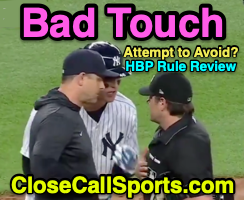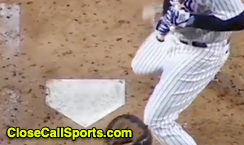Official Baseball Rule 5.05(b)(2) governs the case of a pitched ball touching a batter: "The batter becomes a runner and is entitled to first base without liability to be put out (provided they advance to and touch first base) when: They are touched by a pitched ball which they are not attempting to hit unless (A) The ball is in the strike zone when it touches the batter [in which event the pitch is deemed a dead ball strike], or (B) The batter makes no attempt to avoid being touched by the ball [in which event the pitch is adjudged as a dead ball {called ball} or strike depending on its location as it struck the batter]."
Replays suggest that New York batter Rizzo, during Rays pitcher Ryan Yarbrough's 3rd inning, 1-2 curveball, not only made no attempt to avoid being touched by the ball, but that Rizzo may have furthermore leaned his leg in toward home plate, in a potential attempt to increase the likelihood that he would be struck by the ball.
After the ball touched Rizzo, Umpire Reyburn immediately enforced OBR 5.05(b)(2) by calling "Time" to acknowledge the dead ball that occurs when any pitched ball touches a batter before declaring a dead ball [called ball] and ordering Rizzo to remain at-bat, ruling that Rizzo failed to satisfy the terms of the rule that would have afforded him free passage to first base.
Sidebar: It is legal for a batter to "crowd the plate," provided that the batter is legally positioned with both feet within the batter's box [including touching the box's lines], and a base awarded should be granted pursuant to OBR 5.05(b)(2) unless either exception A [ball in strike zone] or B [makes no attempt to avoid] applies.
On Monday night in New York, Reyburn ensured the rule's attempt-to-avoid provision was applied.
Video as follows:
Alternate Link: Rizzo touched by pitch, but ump Reyburn orders him to stay at home plate (NYY)
Video as follows:
Alternate Link: Rizzo touched by pitch, but ump Reyburn orders him to stay at home plate (NYY)


